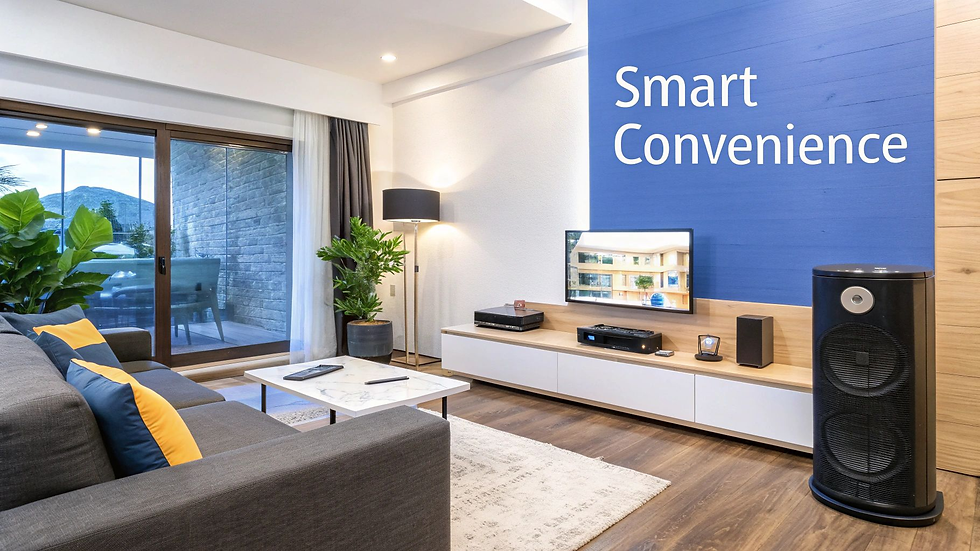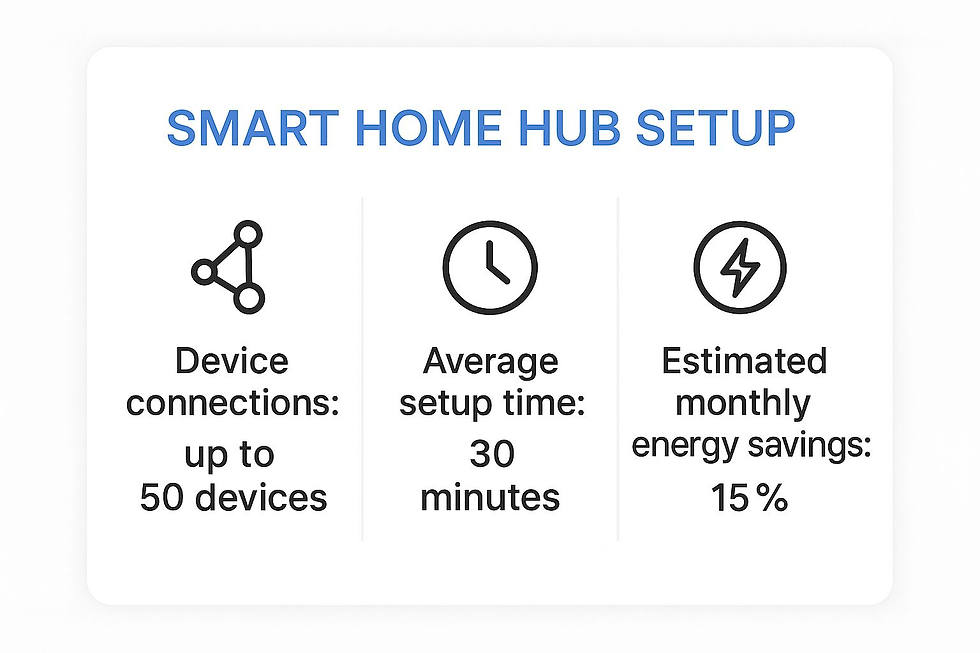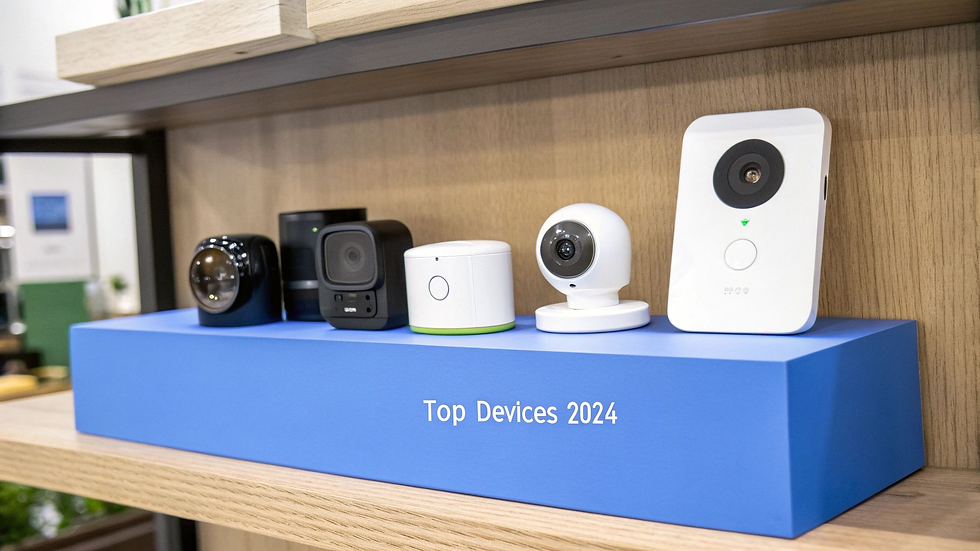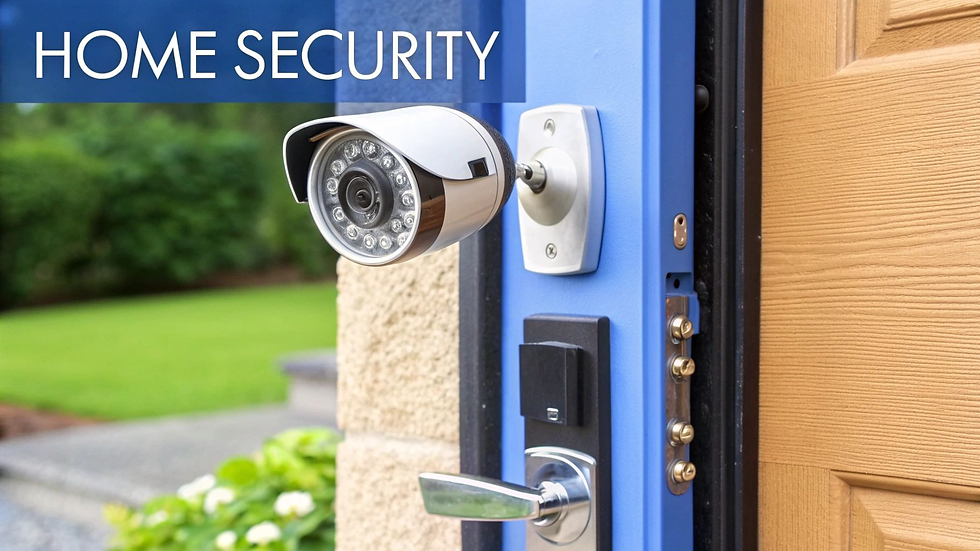Your Guide to a Tech Smart Home
- Justin McCurdy

- Sep 19
- 13 min read
So, what exactly is a “tech smart home”? Forget the clunky, futuristic images you might have seen in old sci-fi movies.
A modern smart home is really just a home kitted out with internet-connected devices designed to make your life easier. Think lighting, thermostats, security, and even your speakers, all working together and controllable from your phone or a central hub. The whole point is to add convenience, save energy, and enhance security. It's about practical solutions for everyday home living.
What a Tech Smart Home Really Means for You
At its heart, a tech smart home is simply a more intuitive and helpful place to live. It’s about building a home that learns your routines and handles the little things for you, so you don't have to.
This isn't just some passing fad; it's a fundamental shift in how we design and live in our homes. The global smart home market has ballooned into a massive industry, valued at around USD 127.80 billion, and it's only getting bigger. You can read the full research on smart home market growth to get a sense of just how mainstream this has become.
But what does this mean for your new home in White Marsh, Maryland or Edgewood, Maryland? It means you have the golden opportunity to plan for these features from the ground up, weaving them into the very fabric of your home instead of trying to shoehorn them in later.
Moving Beyond Basic Gadgets
A truly smart home is so much more than a pile of cool gadgets. It’s a fully integrated ecosystem where all your devices talk to each other to create seamless, helpful experiences.
Picture your morning routine—a practical example:
Your blinds automatically glide open to greet the sunrise.
The thermostat has already warmed the house to your perfect "get out of bed" temperature.
Your favorite morning playlist starts playing softly from the kitchen speakers as you walk in to make coffee.
That’s the magic of real automation. It’s the difference between having a few smart plugs and having a home that genuinely works for you.
The goal isn’t to stuff your house with tech just for the sake of it. The real win is using technology to solve everyday annoyances and give you back more time and a little more peace of mind.
While the builder I represent provides high-quality homes in amazing Maryland communities like those in Baltimore County and Harford County, I go a step further. My job is to help you make that space uniquely yours. I offer hands-on service and access to unique visualizers that help you bring your dream space to life, from choosing the perfect flooring and countertops to integrating the tech that fits your lifestyle.
Ready to plan a home that’s not just beautiful, but brilliantly functional? Let’s connect and start the conversation.
Planning Your Home’s Tech Infrastructure

The real secret to a killer smart home isn't the flashy gadget you buy last—it's the planning you do before the drywall ever goes up. Seriously, this is your single biggest advantage. Getting the infrastructure right from the start makes your home ready for the tech you want today and whatever amazing stuff comes out tomorrow.
Think about it like plumbing or electrical work. You wouldn't dream of building a house without figuring out where the sinks and outlets go. The same exact logic applies to your home's digital foundation. A little bit of planning here prevents massive headaches later, like dead Wi-Fi zones in the master bedroom or realizing you can't install a new smart device where you really need it.
Laying the Digital Groundwork
First things first: you need a rock-solid network. Your smart devices are only as smart as their connection, so strong and reliable Wi-Fi across every square foot of your property is non-negotiable. For all your gear to work seamlessly, you need a powerful signal everywhere. Learning about extending your WiFi range is a good first step to kill those dead zones before they even appear.
But Wi-Fi is only half the story. We also need to talk about structured wiring. This is just a friendly term for running physical cables—like Ethernet (Cat6) and coaxial—to key spots throughout the house while the walls are still open.
Here’s a practical look at why this is an absolute game-changer:
Ultimate Reliability: A hardwired connection will always be faster and more stable than Wi-Fi. It’s perfect for things that can't afford to drop out, like your main smart TV, a home office computer, or high-definition security cameras.
Future-Proofing: Who knows what tech we'll have in five years? A wired backbone gives you options. When you decide to add that next-gen media server, the port will be right there waiting for you.
Less Wi-Fi Congestion: By plugging in your stationary devices, you free up the wireless airwaves for the things that actually move, like your phone, laptop, and tablets.
A huge mistake I see people make is thinking, "I'll just use Wi-Fi for everything." I have clients all over Baltimore County and Harford County who are so thankful they invested in proper wiring. It’s the invisible hero of a smart home that just works.
Creating a Central Tech Hub
So, where do all these wires go? They all run back to a central hub, which can be a small "tech closet" or a structured media cabinet. This is a dedicated spot, tucked away in a utility room or basement corner, that neatly houses your modem, router, and any network switches.
This approach hides all the blinking lights and cable mess, keeping your home's design clean and uncluttered. Even better, it gives you one central place to manage or troubleshoot your network. No more digging behind the entertainment center to find the router. Planning this space from the get-go is a small detail that pays off big time in the long run.
When we're designing your new home in places like White Marsh, Maryland or Edgewood, Maryland, I'll help you map all this out. We’ll go through a checklist to make sure we're running wires to all the logical spots—home offices, media rooms, and even outside for cameras or landscape lighting. This hands-on service is what separates a house that just has a few gadgets from one that's a truly intelligent, connected home.
Choosing Your Smart Home Ecosystem
Think of your smart home ecosystem as the central nervous system for your house. It's the language all your gadgets will use to talk to each other, and it's the single most important tech decision you'll make. This choice dictates how you'll interact with everything—from your lights and locks to your speakers and thermostats—for years to come.
The big three players in this space are Amazon Alexa, Google Assistant, and Apple HomeKit. Each has its own personality, its own strengths, and its own ecosystem of compatible devices.
Instead of just rattling off a list of features, let's talk about what it feels like to live with each one. For instance, if your family is already deep into the Apple world with iPhones and iPads, Apple HomeKit often feels like a natural, friendly extension of what you already know. On the other hand, if you want the absolute widest selection of gadgets to choose from, Amazon Alexa is tough to beat.
Amazon Alexa: The undisputed champion of compatibility. It works with thousands of devices, making it incredibly easy to add new gadgets over time.
Google Assistant: If you love conversational, intuitive voice commands, this is where Google Assistant really shines. It's also the native platform for all Nest products, which is a big plus for many homeowners.
Apple HomeKit: Apple’s walled garden approach puts a heavy emphasis on privacy and security. It’s slick, and the integration with iOS is seamless.
The entire smart home market is booming, largely because these systems are getting smarter every day. They're learning our routines and anticipating our needs, which is a huge leap forward. According to some smart home market growth findings on Precedence Research, this trend is only accelerating.
Smart Home Ecosystem Comparison
To give you a better sense of how these platforms stack up, I've put together a quick comparison table. This isn't about which one is "best," but about which one is the best fit for your lifestyle and technical comfort level.
Feature | Amazon Alexa | Google Assistant | Apple HomeKit |
Ease of Use | Very intuitive, guided by the Alexa voice app. | Feels the most natural for voice commands. | Deeply integrated into your iPhone's settings. |
Device Compatibility | Strong lineup with over 1,500+ Nest and other devices. | More curated list of 1,000+ certified devices. | |
Reliability & Privacy | Solid cloud-based performance. | Fast responses, often processed locally. | Strongest focus on privacy with local control. |
Ultimately, the best choice often comes down to what you're already using. An Android user will likely have a better experience with Google Assistant, while an iPhone user will find HomeKit a breeze. Alexa is the great equalizer, working well with almost everything.

This data gives you a practical look at what to expect. A well-planned system can handle up to 50 devices, be up and running in under 30 minutes (when wired during construction!), and can even trim your utility bills by about 15% each month.
My Takeaway: Don't get bogged down by the sheer number of devices. Focus on a hub that feels intuitive to you and supports the core things you want to automate. A system that’s easy to use is a system you’ll actually use.
What It's Like to Live With Your Choice
When I talk to clients in White Marsh, Maryland or Edgewood, Maryland, the conversation always comes back to one thing: reliability. No one wants to yell at their lights three times for them to turn on.
Here are some practical examples of why you might choose one over another:
HomeKit users love the convenience of Siri shortcuts because it mirrors how they already use their phones.
If you're someone who loves to tinker and add new gadgets all the time, Alexa's massive device library is almost impossible to pass up.
If your home already has a Nest thermostat and Google speakers, staying with Google Assistant just makes sense for a seamless experience.
This is especially critical for things like security cameras and smart locks. HomeKit’s emphasis on local processing is a real advantage here—if your internet connection gets a little spotty, your commands are more likely to still work because they aren't relying on a distant server. It just means fewer headaches.
So, how do you make the final call for your new home in Baltimore County, Maryland or Harford County, Maryland? The best way is to see it in action. My hands-on service includes walking you through demos that are tailored to your life. We'll help you see how these different technologies look and feel alongside your flooring, cabinet, and other finishing choices, so you can make the best choice for you.
Picking Your First Smart Home Gadgets

Alright, now for the fun stuff—choosing the tech that actually brings your smart home vision to life. This is where you really get to customize your space and solve those little everyday annoyances with some clever automation.
Think of it less like you're just buying electronics and more like you're designing experiences. Imagine your lights slowly brightening in the morning to wake you up gently, or getting a quick ping on your phone when a package is dropped off while you're out. These are the small, almost magical moments that make a smart home so cool.
The trick is to start with devices that will have the biggest, most immediate impact on your daily life. Let’s look at the best places to begin.
Smart Lighting and Climate Control
This is hands-down the best entry point for most people because the benefits are instant. Smart lighting and climate control are all about dialing in the perfect atmosphere while also trimming down your energy bills.
Smart Thermostats: A device like the Google Nest or Ecobee is a no-brainer. It learns your routine and adjusts the temperature on its own, saving you money without you lifting a finger. A practical example: it can cool things down when you leave for work and then get the house comfortable again right before you pull into the driveway.
Smart Bulbs and Switches: With brands like Philips Hue or Wyze, you can control the brightness and even the color of your lights right from your phone. You can create a "movie night" scene that dims the lights perfectly with a single voice command.
Automated Blinds and Shades: Now this feels like true luxury. Imagine your shades automatically closing during the hottest part of the day to keep your White Marsh, Maryland home cool, then opening back up to let in that beautiful afternoon sun.
Security and Smart Access
You can't put a price on peace of mind, and that’s exactly why smart security gear has become so popular. We’ve seen massive growth in this area, which just goes to show how much homeowners value feeling safe and connected to their property.
In fact, about 63% of households in the United States now own at least one smart home device, and security systems are a huge part of that.
Here are the heavy hitters in this category, with practical uses:
Video Doorbells: See and talk to anyone at your door, from anywhere. It's perfect for verifying a delivery or telling a friend you're just five minutes away.
Smart Locks: Stop fumbling for your keys! You can unlock your door with your phone or a simple code, and even give a temporary access code to a dog walker or houseguest without having to copy a key.
Security Cameras: Today's cameras give you crystal-clear video, motion alerts, and two-way audio. It’s like having a direct line to your home, whether you’re across town or on vacation.
My most important piece of advice: As you choose your devices, double-check that they are compatible with the ecosystem you picked earlier (Alexa, Google, or HomeKit). This will save you the massive headache of trying to manage ten different apps just to run your house.
Entertainment and Convenience
This last category is all about making your home a more enjoyable and efficient place to live. From whole-home audio to smart appliances, these gadgets add a layer of convenience that you'll quickly wonder how you ever lived without.
For example, when you're looking at what to install from day one, it's worth comparing different smart garage door openers to see which features best suit your lifestyle.
Placing a smart display like an Amazon Echo Show or Google Nest Hub in the kitchen can be a total game-changer. You can pull up recipes, watch a show while you cook, or video call family, all completely hands-free. This is the kind of practical tech I love helping my clients integrate into their new homes across Baltimore County, Maryland and Harford County, Maryland.
Bringing Your Smart Home Vision to Life

This is my favorite part—where all the planning clicks into place and your vision starts to become a tangible reality. You've already made the big decisions on the beautiful finishes you want by getting to pick your flooring, countertops, cabinets, and tile. Now, we get to weave your chosen smart technology into the fabric of your home.
The goal here is to make sure your smart home feels truly integrated, not just like a collection of cool gadgets you've tacked on as an afterthought. We're bridging the gap between your interior design choices and the tech that will power your daily life.
Visualizing Your Connected Space
Instead of just crossing our fingers and hoping everything looks good, we can actually see it all come together beforehand. Using some powerful visualization tools, I can show you exactly how your new tech will fit into the home's aesthetic. It's one thing to imagine it, but it’s a game-changer to see it.
Here are some practical examples of how we use these tools:
We can preview how a sleek smart display will look on the new kitchen island, making sure it doesn't disrupt the clean lines of the quartz countertops you chose.
We can find the most discreet, acoustically-perfect spot for smart speakers in the living room so they blend right in with your custom cabinet selections.
This process is so much more effective than just looking at product photos online. If you're into using tech for planning, you should also check out our guide on the **12 best home improvement apps for your 2025 projects**.
This is a hands-on process that ensures the design and the technology of your new home in communities like those in Prince George's County, Maryland are perfectly aligned. It’s about more than just picking finishes; it’s about co-creating a home intelligently designed for how you live.
From Blueprint to Reality
My role is to guide you through this, offering a much more hands-on service. We'll sit down and talk through your daily routines, mapping out exactly how your smart tech can make life a little bit easier and way more enjoyable.
Whether you're building in White Marsh, Maryland or Edgewood, Maryland, the mission is always the same: create a space that’s as brilliantly functional as it is beautiful.
This collaborative approach guarantees your home is ready to support your lifestyle from the moment you get the keys. Let’s find a time to explore these tools and start designing your dream space together.
Common Smart Home Questions Answered
Diving into the world of smart homes can definitely bring up a few questions. From costs to what happens when the power flickers, it's totally normal to wonder about the practical side of things. Let's tackle some of the most common queries I hear from clients in a friendly, helpful way.
Do I Need to Be a Tech Expert to Run a Smart Home?
Not at all. I tell my clients this all the time: if you can use a smartphone, you can run a smart home. These systems are designed for real people, not IT pros.
The trick is to pick one main "brain" for your home—think Amazon Alexa or Google Assistant—and then choose devices that play nicely with it. For example, setup is often as simple as scanning a QR code with your phone and following the friendly prompts in an app.
Plus, when you’re building your new home with us, we handle the really technical part—the wiring and initial setup—before you even get the keys. My job is to help you find a system that makes life easier and more fun, not one that feels like a second job.
Is a Smart Home Really Expensive?
This is probably the biggest misconception out there. The beauty of a smart home is that it’s completely scalable. You don't have to go all-in on day one.
You could start with a smart thermostat and a video doorbell, see how you like it, and then add more devices down the road. The real financial win is planning for it during the home buying process. Getting the wiring right from the start saves a ton of money compared to retrofitting, which can mean tearing into perfectly good drywall later.
The smartest investment you can make is in the foundation: the pre-wiring and a rock-solid Wi-Fi network. Nail that, and you can build out your smart home at whatever pace your budget allows. Smart planning beats a huge upfront budget every time.
What Happens if the Internet Goes Down?
This is a great question, and an important one. The short answer is: you won't be locked out or left fumbling in the dark. Your home’s core functions will still work the old-fashioned way. A light switch still turns on the light, and your physical key still unlocks the front door.
Many devices are also smart enough to keep working on your local Wi-Fi network even if your internet service is out. For something as critical as security, you can opt for cameras with local SD card storage. That way, they keep recording footage no matter what. We dive deeper into these kinds of fail safes in our guides on smart home security. It’s all about having that peace of mind.
While the builder I represent provides high-quality homes in fantastic Maryland communities like White Marsh, Maryland; Edgewood, Maryland; and throughout Baltimore County, Maryland; Harford County, Maryland; and Prince George's County, Maryland, I go a step further. I'm here to offer you unique customization tools, hands-on service, and access to visualizers that help bring your dream space to life. We empower you to customize your home by picking your flooring, countertops, cabinets, tile, and more. Ready to see how we can help create a space that's truly yours? Visit https://www.customizeyourhome.com to get started.

Comments